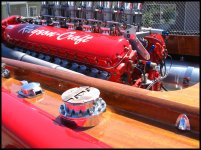Never have, never will. APS IMO sucks. Here in Holland it was always more expensive developing costs-wise. Plus the smaller neg gave horrid results when printed on anything bigger then 8x13. Also, the pano mode was cool except for the cutting off of the top and bottom part of the neg, resulting in even less film to print, and these prints were double the size of a normal print. Result: even at arm's length a pano print of 10x30 (or such) looked extremely poor. A friend of mine used the APS version of the Canon Eos line, and I'm glad she did; so I didn't get tempted to buy one too. 🙂




